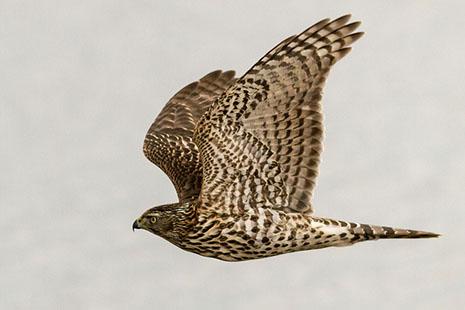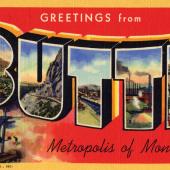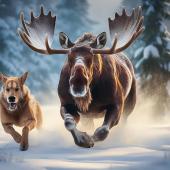The Grey Ghost
A chance encounter with the northern goshawk.
I am walking in the foothills of the Custer-Gallatin National Forest on a recent morning, still bleary-eyed and not as alert as I should be. At 6,200 feet of elevation, this country is a textbook example of the montane ecotype: a paradise of lush meadows interspersed with conifer-dominated forest. It is the kind of landscape our ancestral hunters would have sought out, with excellent grazing habitat and wooded areas in ideal proportion.
Low-angle morning light casts a glow on this quiet world. When I come around a bend in the trail, a striking, slate-colored blur catches my eye. It flies directly into a dense thicket of trees without slowing.
Even in my dreamlike state, I’m surprised, gasping when it registers in my mind what I’ve seen: the “gray ghost” of the woods, a northern goshawk.
This bird is the largest of our three Accipiter species in Montana. It is a creature that often prefers mature forests for nesting, especially those near meadow complexes; ecotones, where two or more habitats meet, are productive hunting areas for these aggressive raptors.
Goshawks (from the Old English “goose hawk”) are capable of impressive speeds when diving on prey, which is interesting given that their wing structure, like that of Cooper’s hawks and other forest-dwelling birds, is rather short and broad and not really suited for high speed. This design, in addition to the bird’s notably long tail, is all about maneuverability through dense woods. To witness them pursue a grouse or other animal into a thicket is a remarkable experience. A goshawk will fold its wings back to fly through very tight spaces between branches. This has the effect of reducing overall lift, but the bird compensates for this by fanning out its substantial tail. Like all raptors in the Accipidridae family, goshawks have oversized optical nerves and more than one million photo-receptor cells per square millimeter in their retinas (by comparison, humans have about 200,000 per square millimeter). This means they absorb a tremendous amount of visual information at great distances and can process it instantly.
An interesting mental exercise is to imagine this bird watching an animated film; where we would see a continuous flow of movement, the raptor sees a broken stream of choppy pictures, because it has sophisticated optical-neurological hardware capable of teasing the images apart. The goshawk uses this great visual acuity to hunt the birds and small mammals it relies upon in both open and densely forested habitats.
These secretive birds are considered a species of concern by the state of Montana. Improper timber harvest activities pose a threat to goshawk nesting habitat. It is currently unknown how natural processes like wildfire and beetle outbreaks will affect the species over time. The U.S. Fish and Wildlife Service was petitioned in 1997 to list the bird under the Endangered Species Act, but such an action was deemed unwarranted. Clearly, more research is needed to assess the overall population trend in the northern Rockies.
I can’t be certain if I stumbled upon a nesting area on my walk. The habitat looks right, but anyone concerned with their own wellbeing should avoid an active nest site, since this bird will defend it with tremendous vigor. I know more than one person who has been knocked to the forest floor and bloodied by a goshawk defending its nest. Literature suggests that pronounced aggression by goshawks in this way may be a defensive adaptation related to black bears preying on chicks.
In a typical season, the bird will produce two to four eggs per clutch and hatching occurs between 28 and 38 days. Both parents provide food for the young. Like many birds of prey, northern goshawks exhibit a dramatic size differential between the sexes. One explanation for this is that it allows the raptors to hunt in different niches; the larger females can take hares and bigger birds, while the males will stick to smaller fare such as mice and voles. Such a system improves the overall intake of food for the young.
The following week, I’m on the same walk thinking about the goshawk I flushed and hoping to get another look. It’s also early morning and again, I’m coffeeless, in that waking dream state, with the strange sensation that no time has passed since I saw the bird here seven days before. But something is different now when I come to that same bit of forest; instead of a flash of gray through trees, I see blonde-gold and hear a thump. As I instinctively draw my pepper spray, a beautiful, grizzly-looking black bear materializes, looks at me through the woods and ambles off.
I know now that my expectation to see the goshawk again is probably unwarranted since I encounter far more bears—both blacks and grizzlies—in a season than I do that particular bird. And it makes me think about an evolutionary link between bears and the secretive “gray ghost.”
I’m standing there questioning if sleepy eyes have deceived me, if any of these events happened at all. This remarkable ebb and flow of species sharing habitat over time, shaping one another, and me stumbling through a country of such dreamy possibilities.
This column, written by David Cronenwett, orginally appeared on mtaududon.org. Montana Audubon is an independent, statewide wildlife conservation organization. Cronenwett is a writer, naturalist, and Audubon staff member who can be reached at [email protected].













